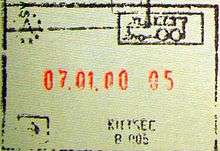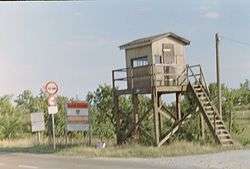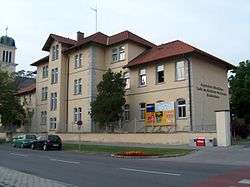Kittsee
Kittsee (Slovak: Kopčany, Hungarian: Köpcsény, Croatian: Gijeca) is an Austrian municipality in the District of Neusiedl am See, Burgenland.
Kittsee | |
|---|---|
New Palace in Kittsee | |
 Coat of arms | |
 Kittsee Location within Austria | |
| Coordinates: 48°04′00″N 17°04′00″E | |
| Country | Austria |
| State | Burgenland |
| District | Neusiedl am See |
| Government | |
| • Mayor | Johannes Hornek (ÖVP) |
| Area | |
| • Total | 19.27 km2 (7.44 sq mi) |
| Elevation | 138 m (453 ft) |
| Population (2018-01-01)[2] | |
| • Total | 3,162 |
| • Density | 160/km2 (420/sq mi) |
| Time zone | UTC+1 (CET) |
| • Summer (DST) | UTC+2 (CEST) |
| Postal code | 2421 |
| Vehicle registration | ND |
| Website | www.kittsee.at |
History


In the Middle Ages, the settlement was situated in the Kingdom of Hungary, and was probably settled by Pecheneg border guards in the 11th century. There was a Hungarian royal castle on the site of the settlement as early as the 12th century. The first documented mention of the settlement was in 1291; the name Koeche was in use in 1390. It is thought that the name is of Hungarian origin and the older form was Küccse.
Since the settlement guards the entrance of the Danube into Hungary, it often played a key role in the defense of Hungary. This was the gathering site of the crusader army of Frederick I in 1198. The town was the site of Géza II's battle with the Austrians, and the wedding of Béla, son of Béla IV and Kunigunda, niece of Ottokar II, King of Bohemia, in 1264. The peace treaty of Andrew III and Albert I was signed here in 1291. After 1363, the town was owned by the Scharfenecki, Szentgyörgyi, Esterházy and Batthyányi families.
In 1455, this was the scene of a meeting between John Hunyadi and Ulrich II of Celje. Ferdinand I received envoys here from Hungary on the way to his coronation in Székesfehérvár. In 1529 and 1683 it was destroyed by Ottoman armies. In 1676, it became the property of the Esterházy family. The town's ancient moated castle, built in the 12th century was first mentioned in 1344, and was destroyed by the Ottomans in 1529. It was replaced by the Grange, built in 1552.
From 1880, the Batthyány-Strattman family were the main landlords in the town. Kittsee was one of the Siebengemeinden of Burgenland.

Kittsee, like the rest of Burgenland, belonged to Hungary until 1920/21. After the end of the First World War, the territory of West-Hungary was given to Austria by the Treaties of St. Germain and Trianon. Since 1921, the town has belonged to the newly founded State of Burgenland.
Politics
Kittsee's mayor is Klaus Senftner of the SPÖ and its vice-mayor is Franz Buchta of the ÖVP. The chief officer is Johann Zierhut.
The political composition of the Municipal Council (21 seats) is SPÖ 11, ÖVP 8, FPÖ 2, Grüne 0, and other lists 0.
Business and infrastructure

The municipality plays an important role as a medical center, because the district's only hospital is located there. It was founded by the ophthalmologist Prince Ladislaus Batthyány-Strattmann, who ran the hospital until 1921. It was named after him in 2004.
Kittsee is also home to a rescue station of the Red Cross.
The town is famous for its 30,000 apricot trees, which are cared for by the Kittsee Apricot Club.
Historical sites
- Remains of a medieval church named after St. Pancratius, only the tower survived after 1529. The original building was erected before 1250. The present-day Church of Exaltation of the Holy Cross was built in 1736 (named Church of Our Lady until 1808).
- The new Castle (Schloss Kittsee) was built in 1668 by expanding the Grange. Since 1974 it houses an ethnographic museum.
- Joseph Joachim's birth-house.
Notable residents
.jpg)
- Joseph Joachim, Hungarian-Jewish violinist and composer, born here on June 29, 1831
- János Listi, Hungarian noble. Baron of Köpcsény (Kittsee), bishop of Győr (Raab) born in Nagyszeben. Ennobled 1554, died 1577 in Prague.
- László Listi (or Listius László), Hungarian noble, poet, owned the "old" Kittsee/Köpcsény castle ca 1635
- László Batthyány-Strattmann, Hungarian noble, medical doctor
Nearby municipalities & sites
- Little mountainous region under the Hundsheimer Berg (480), Königswarte (344), Spitzerberg (302) (NÖ)
- * Berg, Neuhof, Pottenburg, Wolfsthal, Rotes Kreuz, Edelstal (Burgenland), Bundessportsschule (under the Spitzerberg), Hundsheim, and Bad-Deutsch-Altenburg, Hainburg, Braunsberg & Röthelstein, also Carnuntum
- Pama, Csardahof, Zeiselhof, Deutsch Jahrndorf in the Heideboden
- Petržalka, Jarovce & Rusovce
- Bratislava - Slovak Capital City
See also
- Summer Archbishop's Palace
References
- "Dauersiedlungsraum der Gemeinden Politischen Bezirke und Bundesländer - Gebietsstand 1.1.2018". Statistics Austria. Retrieved 10 March 2019.
- "Einwohnerzahl 1.1.2018 nach Gemeinden mit Status, Gebietsstand 1.1.2018". Statistics Austria. Retrieved 9 March 2019.
- The information in this article is based on a translation of its German and Hungarian equivalents in the Wikipedia.
External links
- (in German) http://www.kittsee.at Kittsee Official Website
- (in German) Kittsee Apricot Club



